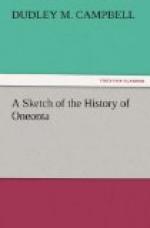[Footnote A: A Free Baptist church had been built at the Plains many years before.]
The first Episcopal services were held in 1839, by the Rev. Andrew Hall, a missionary to Oneonta and Otego. At first the society met in the school-house of the village, and afterwards built a chapel on the lot now occupied by a part of the Central Hotel. The clergy have been as follows: Rev. Andrew Hall, 1839; Rev. Stephen Parker, 1855; Rev. D.S. Tuttle, 1864-65; Rev. E.N. Goddard, 1865; Rev. Mr. Foote and Rev. Mr. Ferguson, 1866-67; Rev. Mr. Lighthipe, 1870; Rev. Mr. Fitzgerald, 1873-74; Rev. J.H. Smith, 1874; Rev. J.B. Colhoun, 1875-78; Rev. J.B. Hubbs, 1880-81; Rev. C.D. Flagler, 1882.—The society was organized under the name of St. James church, April 7, 1870.
The “First Universalist Society of Oneonta” was formed Dec. 12, 1877. The meeting house was built in 1878-79. The pastors have been Rev. L.F. Porter, 1877-81; Rev. H. Kirke White, 1882—.
The Catholic society now numbers about three hundred. Services have been conducted heretofore by Rev. J.J. Brosnahan, of Cobleskill, till July, 1883, when the Bishop created a new parish at this place and appointed Rev. James H. Maney (of St. Mary’s Church, Albany), who is now the resident pastor. The parish under the charge of the Rev. Mr. Maney extends from the Cooperstown Junction to the Harpersville Tunnel. This society is about to erect a church edifice on a lot already purchased for that purpose.
The “Oneonta Union School” was organized in 1867. The sum of $5,000 was first voted for the purpose of building a schoolhouse, and afterwards the sum was increased to $7,500. The building was finished and school opened in 1868 with Wilber F. Saxton as principal. Mr. Saxton resigned his position in 1870, and was then succeeded by Nathaniel N. Bull as principal. In 1873 the needs of the school were met by the building of a smaller schoolhouse in the lower part of the district. In 1874 and in 1880 the main school building was enlarged to accommodate the increased attendance of scholars. An academic department was organized in 1874. The school is attended by about six hundred pupils, and twelve teachers are employed. Mr. Bull is still the efficient principal, and his labor is shared by competent assistants.
The business industries and enterprises of the village consist of a number of large dry goods and clothing stores, several shoe stores, nearly a dozen grocery and provision stores, two or three bakeries, confectionery establishments, flour and feed stores, several builders’ machine shops, three saw mills, three grist mills, furniture stores, three large hardware stores, the railroad machine shops, round-houses, carriage factories, coopers’ and blacksmith shops, three drug stores, two well-equipped printing offices, each of which issues a carefully edited and well patronized newspaper—Herald and Democrat and Oneonta Press. There are two banks—the “Wilber National” and “The First National”—both of which are doing a large business and are under prudent management. There are a dozen or more lawyers and as many physicians. Three roomy hotels care for and furnish entertainment to the way-faring public, and another hotel is in course of construction.




